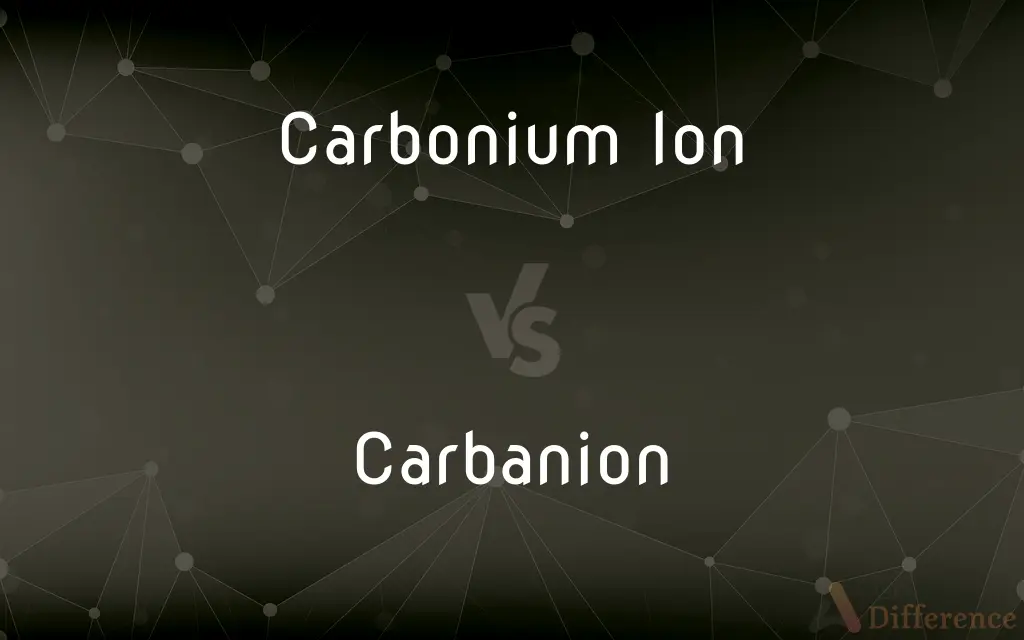Carbonium Ion vs. Carbanion — What's the Difference?
By Tayyaba Rehman — Published on January 15, 2024
A carbonium ion is a positively charged ion (cation) with a carbon atom, while a carbanion is a negatively charged ion (anion) also centered on a carbon atom.

Difference Between Carbonium Ion and Carbanion
Table of Contents
ADVERTISEMENT
Key Differences
Carbonium ions are positively charged species (cations) where the charge is centered on a carbon atom. These ions typically have a trivalent carbon atom with a positive charge. Carbanions, in contrast, are negatively charged species (anions), where a carbon atom carries a negative charge, usually resulting from the carbon having a lone pair of electrons and being tetravalent.
The formation of carbonium ions occurs typically in acidic conditions or during electrophilic reactions where a carbon atom loses an electron or electrons. These ions are often intermediates in organic reactions such as alkylations and rearrangements. Carbanions, however, form typically in basic conditions or during nucleophilic reactions, where a carbon atom gains an electron or electrons, often acting as intermediates in reactions like nucleophilic substitutions.
In terms of stability, carbonium ions are generally less stable due to the positive charge on the carbon atom, which is an electronegative element and prefers to have a full valence shell. Stabilization often occurs through resonance or hyperconjugation. Carbanions, while also reactive, can be more stable if the negative charge is delocalized through resonance or if the carbon is bonded to more electronegative atoms.
Carbonium ions typically participate in reactions as electrophiles, attracting electron-rich species due to their positive charge. They are often found in acidic environments and can lead to protonation of various substrates. Carbanions, being negatively charged, act as nucleophiles and are attracted to electron-poor regions in molecules, often reacting in basic environments.
The reactivity of carbonium ions and carbanions also depends on their structure and substituents, which can either stabilize or destabilize the ion. The nature of the solvent can also significantly affect the stability and reactivity of both types of ions, with polar solvents often playing a crucial role.
ADVERTISEMENT
Comparison Chart
Charge
Positively charged (cation)
Negatively charged (anion)
Formation
Typically in acidic conditions
Typically in basic conditions
Stability
Less stable, needs stabilization
More stable if charge is delocalized
Reactivity
Acts as an electrophile
Acts as a nucleophile
Common Reactions
Electrophilic reactions
Nucleophilic substitutions
Compare with Definitions
Carbonium Ion
Electrophile in Reactions: Acts as an electrophile.
The carbonium ion readily accepted electrons from the nucleophile.
Carbanion
Negatively Charged Carbon: A carbon atom with a negative charge.
The carbanion was stabilized by resonance in the molecule.
Carbonium Ion
Formation in Acidic Conditions: Forms in acidic environments.
Acidic conditions facilitated the formation of the carbonium ion.
Carbanion
Intermediate in Basic Conditions: Forms in basic conditions.
In the basic medium, a carbanion was generated as an intermediate.
Carbonium Ion
Reactivity with Electron-rich Species: Reacts with electron-rich species.
The carbonium ion reacted with the aromatic ring due to its electron-rich nature.
Carbanion
Nucleophile in Reactions: Acts as a nucleophile.
The carbanion attacked the electrophilic center in the reaction.
Carbonium Ion
Intermediate in Organic Chemistry: Common intermediate in organic synthesis.
The synthesis pathway involves a carbonium ion intermediate.
Carbanion
Stabilized by Resonance: Can be stabilized through resonance.
Resonance structures helped stabilize the carbanion.
Carbonium Ion
Positively Charged Carbon: A carbon atom with a positive charge.
In the reaction, the formation of a carbonium ion was a key step.
Carbanion
Reactivity with Electron-poor Species: Reacts with electron-deficient regions.
The carbanion targeted the electron-deficient carbon in the molecule.
Carbanion
An anion in which carbon carries a negative charge and an unshared pair of electrons.
Carbanion
(organic chemistry) any organic anion of general formula R3C- Category:en:Carbon
Common Curiosities
Are carbanions always negatively charged?
Yes, carbanions have a negative charge due to an extra pair of electrons on the carbon.
What is the role of carbanions in organic chemistry?
They act as nucleophiles in various organic reactions.
Do carbonium ions have a lone pair of electrons?
No, they do not have a lone pair; they are electron-deficient.
What makes carbonium ions unstable?
The positive charge on the electronegative carbon atom contributes to their instability.
How can the stability of carbonium ions be increased?
Stability can be increased through resonance or hyperconjugation.
Can carbanions form in acidic conditions?
They usually form in basic conditions, as acidic conditions would protonate the anion.
Are carbanions used in industrial applications?
They are primarily used in research and organic synthesis, not widely in industry.
What affects the stability of carbanions?
Their stability is influenced by factors like resonance, inductive effects, and hybridization.
Are carbanions more reactive than carbonium ions?
Their reactivity depends on the context, but carbanions are generally quite reactive.
Can carbonium ions be found in nature?
They are usually formed in laboratory conditions, not commonly found in nature.
What type of reactions do carbonium ions undergo?
They typically participate in electrophilic reactions like alkylations.
Are carbonium ions found in biological systems?
They can be intermediates in some biochemical reactions, but are not common.
Can carbonium ions be observed directly?
They are usually detected through spectroscopic methods, as they are short-lived.
Is the formation of carbanions reversible?
Yes, depending on the reaction conditions, their formation can be reversible.
How are carbanions detected in a reaction?
They are often inferred from the products formed or detected using spectroscopic techniques.
Share Your Discovery

Previous Comparison
PNG vs. JPG
Next Comparison
Diapers vs. Pull-UpsAuthor Spotlight
Written by
Tayyaba RehmanTayyaba Rehman is a distinguished writer, currently serving as a primary contributor to askdifference.com. As a researcher in semantics and etymology, Tayyaba's passion for the complexity of languages and their distinctions has found a perfect home on the platform. Tayyaba delves into the intricacies of language, distinguishing between commonly confused words and phrases, thereby providing clarity for readers worldwide.












































